First published in New Power Report, December 2017
Katie Black, head of transport, energy and digital at National Infrastructure Commission, talks to Janet Wood about how her responsibilities converge, and about consulting in how to take the UK’s infrastructure forward
At the National Infrastructure Commission, digital, energy and transport come as a package and they are all under the aegis of Katie Black. The commission published its Congestion, Capacity and Carbon consultation in October, an important step in developing a National Infrastructure Assessment designed to look forward for the next three decades. In that document, digital was in the lead. I ask Black whether it has become a more important infrastructure driver than energy.
 It’s not taking energy’s place, she says. “Firstly digital is at a point where it is undergoing quite a rapid transformation. It is changing a lot as a sector. And secondly, all the other sectors that we look at are becoming increasingly dependent on it… it is increasingly looking like energy – a fundamental thing that underpins everything else.”
It’s not taking energy’s place, she says. “Firstly digital is at a point where it is undergoing quite a rapid transformation. It is changing a lot as a sector. And secondly, all the other sectors that we look at are becoming increasingly dependent on it… it is increasingly looking like energy – a fundamental thing that underpins everything else.”
She says the pace of change in digital is “really, really fast”. She explains: “It’s been very challenging for us because the purpose of the National Infrastructure Assessment is to look on a 30-year timeline.” The attitude towards that timeline varies. “In energy, people are used to the 2050 concept because of the Climate Change Act, and [the period] feels suitable for the long-term management of infrastructure assets. In water we get told it is not long enough.” As for digital: “We try to talk to people for time periods beyond five years and some people say we’re crazy.”
New players on the horizon
Digitalisation is a buzzword in the energy industry. What is the dividing line between energy and digital?
“Where it all comes together is in the home,” Black says. “You have a smart meter and smart heating controls and everything starts becoming much more digitally connected. Then it starts to interface with your communications, so it is on your smartphone.
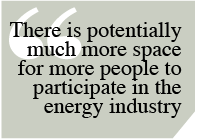 “There is potentially much more space for more people to participate in the energy industry. So people talk about tech companies providing energy services, as opposed to your typical energy retailer. Then you start thinking about electric Vehicles. What does that look like and who are the people who are selling that to you? You could end up having a supplier for your electric vehicle and one for your house. I think there is a lot of thinking to do about how we open up these industries so consumers are able to make the most of all these opportunities and get the best experience and deals.
“There is potentially much more space for more people to participate in the energy industry. So people talk about tech companies providing energy services, as opposed to your typical energy retailer. Then you start thinking about electric Vehicles. What does that look like and who are the people who are selling that to you? You could end up having a supplier for your electric vehicle and one for your house. I think there is a lot of thinking to do about how we open up these industries so consumers are able to make the most of all these opportunities and get the best experience and deals.
“I do think the boundaries between energy and digital, and also with transport, will start to blur over time and you have lots of different business models that we haven’t really thought of yet. A lot of this technology is here now and I think there is a lot more that we could be doing to make that happen.”
Governance framework
With so much change in view, is the structure and governance of those three industries fit for purpose?
“The great thing about being in this organisation is that you do see things from a cross-sectoral perspective in a way that you don’t in a government department. The similarities and difficulties become more obvious to you.”
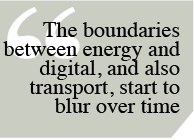 She explains: “Initially we are trying to stay away from the regulatory side of things but it starts coming up.
She explains: “Initially we are trying to stay away from the regulatory side of things but it starts coming up.
“As an organisation, I don’t think we have properly worked out where we want to sit with that. If you look at the interim NIC assessment there are definitely questions that we ask that refer to regulation – some of them explicitly.”
The commission has not asked any specific regulation questions for energy yet, but Black expects to start digging into that. “Are some of these regulated industries set up and regulated in the right way to achieve the level of transformational change that will be required, particularly in energy? My gut feeling is probably the governance is not quite right. Do I have a detailed answer? Not yet.”
Paying your way
A key principle for NIC in energy is that people should be paid for the benefits they provide, but they should also pay the costs that they impose, and she says: “There are some examples that are fairly easy to point to where that isn’t the case at the moment.” Next year’s final National Infrastructure Assessment will ask whether there are any areas of misplaced reward or cost “that will become more of a problem over time and that we should look at fixing now”.
When I ask her to name the areas where there are concerns, she says work is “still at an early stage”. But she adds: “A lot of this is on the small generators side. People talk about moving to a more decentralised energy system as if it is completely inevitable. I think I would slightly push back on that as an inevitable concept.”
We are moving towards decentralisation, and it is incentivised, but “not as we would necessarily want to at the moment”. She says the NIC has to “think about whether that is going to result in least-cost energy for consumers”.
“The cost of low-carbon energy has come down massively, but if you want to decarbonise everything there are some parts that are going to be more expensive. So you really need to get all the cost reduction that you can, in all the areas that you can. You don’t want to be paying more for low-carbon technologies than you need to.
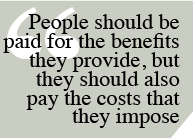 “Something that we are trying to work out is what the mix [between centralised and decentralised] might look like. This move to decentralisation may not make sense from a system perspective. It may not optimise the way we decarbonise and therefore we should think about where you are encouraging [generation] on the system.
“Something that we are trying to work out is what the mix [between centralised and decentralised] might look like. This move to decentralisation may not make sense from a system perspective. It may not optimise the way we decarbonise and therefore we should think about where you are encouraging [generation] on the system.
“Storage is another good example. Storage has to be put in the right place to provide the maximum benefits to the system, rather than putting it where it will actually impose costs on the network.”
Does that mean limiting the choices of those who want to invest? She says no, but if your choice is going to make things more expensive, “then everyone else shouldn’t pay for that – you should; that’s the principle we set out”.
Some argue that it is cheaper for the system when some costs are socialised. She acknowledges that may be the case, saying: “It is definitely the case that you have to decide rather than applying the principle to everything. It is at an evidence-gathering stage.”
I ask how the commission can look up to 30 years ahead in this fast-changing environment. She says: “We are not aiming to redesign the schemes and we are not aiming to provide answers for every possible problem – it’s just not within our remit. I would see our role as indicating to government when what they are doing is inconsistent, or from all from the evidence in front of us it doesn’t seem to make sense for the long term, or is leading to a non-optimal outcome. We would make a recommendation to government, but coming up with a solution is not something that we will be able to do.”
Does she have those same concerns about the Electricity Market Reform (EMR) framework? That was considered in NIC’s interim report, and “we found very few people that thought you should in the medium term rip up EMR and have a new framework”. “Most people wanted stability and certainty. We would agree with that.
“I think there is a longer-term question about whether it holds for 30 years. Dieter Helm’s report starts to explore that, which is why it is a useful thing to have out in the public domain. But what the electricity markets will look like in 30 years’ time is not clear.”
Black wants to test the EMR framework against its aims, but hold on to it “until we have a greater sense of certainty about what things might look like”. “Everyone thinks it is a pretty useful set of tools to achieve what we want to do.”
One proposal from the NIC is to remove inconsistencies between the way carbon savings are incentivised at different scales – between the feed-in tariff and contracts for difference, for example. Black says that is a test of its principle of cost and benefit reflectivity. “Why is there not more equal treatment for small and large generators? You could imagine you would offer the price of a CFD to a smaller generator. They probably would have greater costs to offset than a large generator, depending on where they are and whether what they are doing is of benefit to that network, but that’s a more logical setup than what we have at the moment.”
It may also help address the issue of “gaming” competing subsidy regimes. But Black says it is “a question we have thrown out there to get people’s views on, rather than a concrete recommendation at this stage”.
Sharing or building?
Another side of distributed generation is local balancing, and sharing assets to avoid congestion is a big industry theme. Black says: “One common theme that comes though in all the sectors is how to make the most of the infrastructure that you have.” An NIC project reporting this month will look at that, and Black says: “Everything basically comes back to data. In the same way that in our artificial intelligence review a lot of that ended up going back to data. Before you can start really maximising the impact of a lot of these technologies you have to get some of these basic things sorted.”
But the NIC’s consultation focused on expanding the grid to deal with congestion, rather than local balancing and sharing. Why was that?
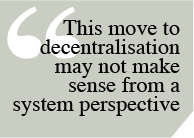 Black says: “It’s partly because we did the Smart Power piece of work, which is very much talks about the need to move towards distribution system operators – having much more active management at the distribution level – and we would still stand by that.
Black says: “It’s partly because we did the Smart Power piece of work, which is very much talks about the need to move towards distribution system operators – having much more active management at the distribution level – and we would still stand by that.
“I don’t think we have a really fixed vision of where the electricity system will end up. I don’t think we would really want to. We want to make sure that as far as possible we are encouraging outcomes that will drive the least-cost low-carbon system and I think that definitely involves a much greater role for actively managed distribution networks – just because there is so much more going on.” As for how much generation is connecting to such networks, Black says: “I don’t know what makes sense yet – and I don’t know if anybody does.
“Instinctively, I am not someone who thinks that we have done away with the need for big power. We are building all these big offshore wind farms and interconnectors. To have an entirely decentralised system… I don’t think it stacks up in terms of the quantum of power that you need. This is part of the work we are doing for the second phase.
“There is definitely a trend towards much more actively managed distribution networks and towards much more going on at the local level ,especially once you start throwing in electric vehicles, storage and more generation. It doesn’t make sense to me that that would be the totality of your energy system.”
Action needed
There are three issues identified in the document that need government action: nuclear, carbon capture and storage (CCS), and decarbonising heat.
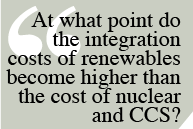 When I ask about them, Black first talks about where there could be less government action. “You can use EMR to deliver a lot of what you need and you can use competition and the markets to get you the cheapest outcome – that’s what you should be focused on. That is the area where you can drive those costs down and we should be trying to do that. There are lots of policy interventions – maybe we can scale those back and keep the framework that we have and just get on with it.
When I ask about them, Black first talks about where there could be less government action. “You can use EMR to deliver a lot of what you need and you can use competition and the markets to get you the cheapest outcome – that’s what you should be focused on. That is the area where you can drive those costs down and we should be trying to do that. There are lots of policy interventions – maybe we can scale those back and keep the framework that we have and just get on with it.
“But there are three things that will not just happen without the government, and that is where government should be focusing its attention and facing up to the decision that it needs to make. That is heat, new nuclear (we are not reopening Hinkley Point, we see that as decided) and carbon capture and storage. The interactions between those three decisions are really the big choices where you need to make a strategic decision and there is a lot of uncertainty, a lot of work to do to understand them and judgement involved. That is what government needs to be thinking about.”
“Nuclear will never be competitive in an auction against offshore wind and they are completely different things. The same with CCS – no one is going to go out and spontaneously build a CO2 pipe and store.”
As for heat, that affects everything, she says, including nuclear and CCS, because it may be needed to produce hydrogen. Alternatively, “if you are decarbonising heat with electricity then you suddenly need a lot more electricity”.
In that case, she says, nuclear is needed, not just for volume but because there are physical limits on the amount of renewables that the UK can access and there may be system-stability issues with a large proportion of renewable generation. “At what point do the integration costs of renewables become higher than the cost of nuclear and CCS? It looks different depending on the proportion of renewables on the system and the mix of renewables… although nuclear is not perhaps your lowest-cost technology, from a system perspective it starts to make sense.”
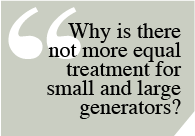 Black says using the levelled cost of electricity is not always helpful because it does not take into account the cost of managing the system. “Those are the questions that we are trying to dig into for the final report.”
Black says using the levelled cost of electricity is not always helpful because it does not take into account the cost of managing the system. “Those are the questions that we are trying to dig into for the final report.”
As for heat, she says: “I don’t think we will come to a decision” and that will be in accord with the Committee on Climate Change, which said we need to come to an a decision on heat in the early 2020s. “BEIS is investigating it and I think it’s positive that they are doing it. Hopefully there is an opportunity with heat to get the decision-making done really well and on time. I don’t feel that we are at the stage where we should necessarily be worried about the lack of progress at the moment.
“What is really important is that people are joining up these decisions and how they make sense across the whole energy system. So that decisions we are making on power are consistent with these different options that we will need to take on heat later.”
But Black does hope to help kick-start public debate. “The first thing is building up awareness of this huge change that will affect every building – no-one knows about it. There are things that we can do, like building awareness of the transition and doing things that work no matter what the future looks like.” She says: “By fleshing out some of the detail of the options, you can start having the debate and you can start holding government to account. We just aren’t in a position to do that at the moment.”
How to win hearts and minds?
I am struck by a chart near the start of the NIC’s Congestion, Capacity and Carbon document that reveals the telecoms industry to be the most popular service – although we all regularly warn of dead spots and rural areas complain of poor service.
I ask Black to speculate about that and she suggests most people remember not having a mobile phone at all, whereas “with energy or water, the quality has probably increased over time but you don’t notice”.
She talks about the pace of change in digital, “where we are seeing a measurable increase in the quality of the service that is being offered”. That may explain why people are more likely to put up with problems. And she says: “I think digital will increasingly become like those other utilities.”
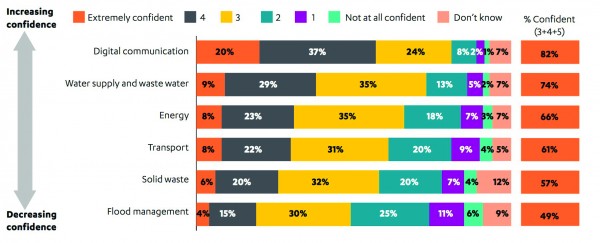
Get in touch
Katie Black is keen to emphasise that NIC is “genuinely doing this as a consultative process”.
She wants input that is wider than the traditional energy industry, and she notes that people in the digital space are less used to interacting in this way than those in the energy industry.“The challenge is interacting with different groups of people in different types of companies but also different groups of the public and making sure that we are really speaking to a diverse range of people. At one of our transport events I think there were eight people called Dave and nine women. Digital and energy are no better.” In response, she says: “We are thinking about lots of different ways to engage. We are doing social research, where we go out and have focus groups with the public about what they think they will want from their infrastructure. We have set up a youth panel so we can get young people’s voices into this.”